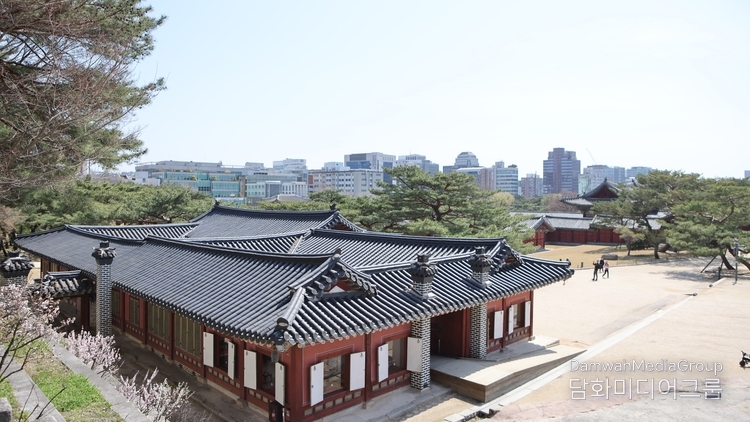By UN Journal Lee Jon-young
In the heart of Seoul's Changgyeonggung Palace, Chundangji (春塘池) is a tranquil spot where cherry blossoms bloom in spring and mallards float in the pond. Amidst this peaceful scene, a strangely disparate stone pagoda stands out. It is the seven-story octagonal stone pagoda of Changgyeonggung Palace, Treasure No. 1119. Many visitors pass in front of it. They read the small sign and think, “Since there is a pagoda, it must be an old cultural property,” and they pass it by.

However, this stone pagoda is not just an old treasure. It was not built on Korean soil, nor is it directly connected to the Joseon royal family. Rather, it is an artifact from another country that was stuffed into the palace as a result of imperialist cultural policies during the Japanese occupation.
“大明成化六年” - This pagoda does not belong to Joseon Dynasty. This is the inscription on the body stone of the octagonal seven-story stone pagoda. 大明 成化六年 庚寅歲 秋七月 上澣吉日造

Detailed Chinese character explanation
大明: It means 'Ming Dynasty'.
成化六年: The sixth year of Emperor Seonghwa's reign in the Ming Dynasty, or 1470 AD.
庚寅歲: The sixth year of the sixty intercalary periods, corresponding to the sixth year of Seonghwa.
秋七月: Autumn, July of the lunar calendar
上澣: Upper month, i.e. the beginning of the month
吉日: Good day, auspicious day
造: Make, build

This means that the pagoda was built in the 6th year of the Ming Dynasty in China, or 1470. The pagoda was not built in Joseon, but rather by an individual in the Chinese region of Yoyang to pray for his own longevity.
The style is also completely different from traditional Korean three-story stone pagodas. The rounded and bulging body stones, the roof stones that mimic a tiled roof, and the octagonal base are all influenced by the Chinese style, especially Tibetan lama pagoda. In other words, the pagoda is a foreign artifact, unrelated to Korean Buddhist art.

How did the pagoda come to Changgyeonggung Palace?
The crucial background is the establishment of the Lee Wang Ga Museum (李王家博物館) at Changgyeonggung Palace during the Japanese occupation in the 1910s. It was a space created by the Japanese to demean the Joseon royal family. The title “Lee Wang” was a title that reduced the Joseon emperor to the level of a relative of the Japanese emperor, and the museum was a way to deny the royal family's majesty and erase its cultural identity by displaying royal artifacts as if they were “stuffed.

The octagonal seven-story stone pagoda is believed to have been purchased by the Japanese in 1911 from a Manchurian trader and brought to Changgyeonggung Palace. In the middle of the palace, a foreign pagoda, unrelated to Korea, was erected. The intent was clear - it was part of a policy of cultural colonization that sought to undermine the uniqueness of Joseon and the independence of the royal family by blurring the symbolic majesty of the palace and mixing disparate cultures.

Chundangji, a royal garden turned zoo and botanical garden
Chundangji, the site of the octagonal seven-story stone pagoda, is not just a pond. It was originally the site of Chundangdae, a royal garden built by Joseon kings to encourage learning, and was a symbolic space that represented royal gardens and education.
However, the Japanese renamed it Changgyeonggung Palace and renamed it Changgyeongwon. In order to remove the authority of the palace and turn it into a place of entertainment for the citizens, they installed a zoo and botanical garden inside the palace.

Chundangji was the centerpiece. The garden image was erased and it was used as an exhibition center to display birds and rare animals around a pond. The king's space was transformed into a place of entertainment, and spiritual symbols were turned into places of consumption.
It's not just an old stone pagoda. It's a vestige of colonialism.
Today, many people pass it by as “a pretty stone tower” or “a quaint artifact”. But a single line of description is hard to convey the meaning of its complex history and a colonial remnant.

Young people, and future generations, need to know the historical context of this pagoda. The pagoda was not built in Korea. It has no connection to the Joseon palace. It is a foreign artifact arbitrarily imported by the Japanese for museum display. It's a symbolic remnant that transformed Changgyeonggung Palace and Chundangji and undermined the royal identity.
How should we view this pagoda?
Although the pagoda is now listed as a treasure, its location and interpretation are still controversial. Should it remain in the palace, be relocated to a separate space, or should the explanatory text be greatly expanded to clarify the historical truth?

Cultural properties are beautiful and valuable in their own, but it's even more important to know the context in which they were built and for what purpose. This pagoda is a concrete example of how the Japanese attempted to deconstruct the royal identity of the Joseon Dynasty and colonize its culture. If we look at it now without knowing it, we may still be living in the silence and distortion they intended.

Changgyeonggung Palace's octagonal seven-story stone pagoda and Chundangji are not “treasures,” but spaces that raise questions.
“Whose is this, and why is it here?” When we can answer that question, we will regain true cultural sovereignty.
